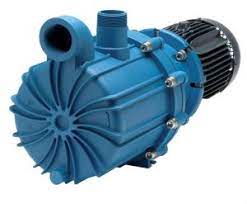
Rotary positive displacement blower equipment (Gardner Denver, Sutorbilt, DuroFlow, etc.) are fairly simple mechanical devices. They consist of two rotors (2 or 3 lobes each) connected by timing gears, rotating inside a cylinder or housing. Their spinning moves air from inlet to outlet, pumping against the system backpressure. Stationary blowers are normally driven by an electric motor through a flexible coupling, v-belt drive, or combination (jack-shaft) drive. Mobile units are commonly driven by PTO from the prime mover drive shaft.
However, while the air is classified as “oil-free”, the blowers do require lubrication for the gears and bearings.
As mentioned in another posting one of the most frequent causes of blower failures is from excessive overhung load. This will primarily affect the drive shaft bearing which takes the brunt of the side loading on the shaft. This can also be transmitted through the rotors to the gears resulting in premature wear and subsequent failure of the gears and gear end bearings. Excessive loading on the drive shaft can also cause the rotors to make contact with each other (“knocking”) and to make contact with the bearing housings (head plates) and the cylinder.
Another frequent failure is from lack of lubrication. Rotary positive displacement blowers require adequate and proper lubrication for all bearings and the timing gears. Generally the gears and gear end bearings are oil splash lubricated. The drive end bearings can be either grease lubricated or oil lubricated (dual splash lubricated). The blower operation manual will specify the amount, quality, and viscosity of the lubricants best used in the blower. Typically, the oil will be a long life synthetic lubricant, and specifics vary due to operating and ambient temperatures.
Inadequate lubrication failures take one of three forms: no oil or not enough oil; too much oil; too long between oil changes and greasing of bearings. Most blowers are shipped without oil, but with tags indicating oil must be added prior to start up. We see a number of brand-new blowers brought in for repair where no oil was added prior to running the blower. This results in catastrophic failure of the gears in short order.
The destructive pattern of the gears is a tell-tale sign of lack of lubrication. Loss of lubricant through leaks or other means can result in overheating and failure of the bearings and gears. Over-filling the oil sumps can also result in failure due to excessive foaming. The failure pattern of the gears is very similar to that of no oil. Infrequent maintenance results in breakdown of the oil and loss of lubricity with subsequent overheating and failure due to premature wear on bearings and gears.
The third most frequent failure in positive displacement blowers is due to over-pressure. An inadequately sized or failed relief valve is one cause of overpressure issues. Overpressure generally results in overheating and warping of the rotors resulting in rotor-to-rotor contact near the center of the lobes. The rotors will subsequently make contact with the cylinder and/or the head plates.
Of course there are other failures, and occasionally a warrantable failure due to manufacturing defect or defective part. These failures if they occur within the manufacturer’s warranty period will be handled by the manufacturer. Pye-Barker Supply Co. and Gardner Denver have an excellent record of handling warranty issues, fairly evaluating every failure with an eye toward customer satisfaction


